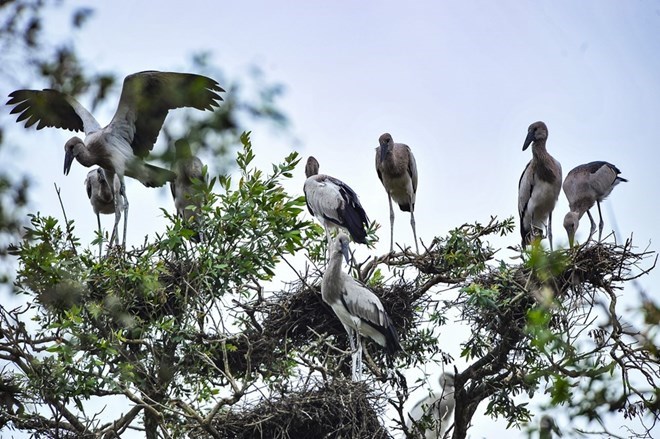
The Mekong Delta province of Dong Thap is working to promote local tourism through three kinds of tourism, namely eco tourism, historical site tourism and community-based tourism.

Birds in Tram Chim National
Park (Photo: VNA)
The province has worked to turn each attraction into unique
tourism products to draw tourists. For example, the Dong Sen-Go Thap art
architecture and archeological complex in Thap Muoi district has the theme of
lotus kingdom and spiritual culture.
Meanwhile, Tram Chim National Park, home to about 200 different
bird species, has focused on Dong Thap Muoi’s natural bird park. It has held
experience tours that allow tourists to become farmers or visit birds in their
breeding season. Flower field tours are also on offer, according to Le Hoang
Long, Director of the Tram Chim National Park.
Aiming to become a flower city of the southern region, Sa Dec city
has launched a green tourism model at Sa Dec flower village, housing more than
2,000 flora species across
470
hectares. The city has also invested in infrastructure
development to improve the environment in the village.
The tourism sector of Dong Thap province has also promoted local
specialities, especially lotus-based products. Other local delicacies, such as
Sa Giang shrimp chips and Lai Vung fermented pork rolls, have been honoured by
domestic and international organisations.
Local farmers have been encouraged to invest in eco-farms to
diversify local tourism and attract tourists to eco-holidays. For instance, Le
Van Ngot, owner of a 4-hectare lotus plantation, offers various services for
tourists to visit lotus field and make lotus-based dishes themselves.
Due to all these efforts, Dong Thap province welcomed 1.6 million visitors,
including more than 40,000 foreigners in the first six months of the year. Its
total revenue from tourism exceeded 300 billion VND, increasing by 39.14
percent against last year and making up 52.17 percent of the yearly plan.
The local tourism sector aims to lure 3.5 million tourists with
earnings of 900 billion VND to 1 trillion VND by 2020 and become one of the
most attractive destinations in the Mekong Delta region.
Source: VNA
A diverse chain of eco-tourism and resort destinations concentrated in Hoa Binh city and the districts of Tan Lac, Da Bac, and Luong Son… Along with the launch of several key high-quality resort tourism projects, these developments have reshaped the landscape and enhanced the appeal of Hoa Binh as a travel destination.
Boasting diverse terrain, a mild climate, and rich natural resources, Cao Phong district is increasingly asserting its place on Vietnam’s tourism map, attracting both domestic and foreign visitors. The district is renowned for its stunning landscapes, majestic mountains, a crystal-clear hydropower lake, and the unique cultural identity of local ethnic groups.
With its pristine landscapes, unique cultural heritage of Muong ethnic minority, and an expanding range of visitor experiences, Tan Lac district of Hoa Binh has fast become a captivating destination for both domestic and international tourists.
Until now, Sung village in Cao Son commune, Da Bac district remains the only Dao ethnic community in Hoa Binh province to develop a community-based tourism model. Beyond its untouched natural landscapes, cultural identity serves as the cornerstone attraction for visitors.
Alongside the diverse cultural identities of the Kinh, Muong, Tay, Thai, Dao, and Mong ethnic people, Hoa Binh province is also renowned as the "capital" of the northwestern Vietnamese cuisine, offering unique and distinctive dishes. At festivals, during Lunar New Year (Tet), or on significant family or community occasions, special dishes are prepared, leaving a lasting impression on visitors.
A Phong Linh (Yellow Tabebuia) flower garden in Thang village, Thach Yen commune, Cao Phong district is currently in full bloom, drawing a large number of visitors.



